“TAKE PITY OF YOUR TOWN AND OF YOUR PEOPLE”
Can International Humanitarian Law protect civilians under siege?
Abstract
It has been argued that the practice of siege warfare is at the very limit of legality under the terms of International Humanitarian Law.[1] The question addressed in this essay might be rephrased: how do the laws of armed conflict permitsieges to become humanitarian disasters? More precisely, can military doctrine regarding the efficacy of siege warfare operations to induce surrender of besieged forces comply in real world terms with the laws of armed conflict? Since February, 2022 it is alleged that Russian armed forces perpetrated a number of crimes against humanity in Ukraine during sieges of cities such as Mariupol. These alleged crimes include indiscriminate targeting of civilian habitation and attacks on evacuation corridors.[2] In the 1990s, siege warfare in the former Yugoslavia provoked international censure and criminal prosecution of perpetrators. Nevertheless, siege operations in Syria and Kashmir today show no sign of respecting the rights of civilian populations despite international censure. The core legal issue regarding sieges is the principle of distinction between combatants and non-combatant civilians and thus decisions regarding targeting and proportionality. The essay will show that distinction is a recent innovation in International Humanitarian Law and uncertainly embodied in military doctrine. The first part reviews evolving IHL norms pertinent to modern sieges. In the second, the essay examines modern jurisprudence regarding the conduct of siege warfare derived from the International Criminal Tribunal for the Former Yugoslavia (ICTY) prosecution of Major General Stanislav Galić and Major General Dragomir Milosević.[3]
[1] Riordan, K., ‘Shelling, Sniping and Starvation: the Law of Armed Conflict and the Lessons of the Siege of Sarajevo’, Victoria University of Wellington Law Review, 41 (2), p.150; Watts, S., Under Siege: International Humanitarian Law and Security Council Practice Concerning Urban Siege Operations’, Research and Policy Paper, CHE Project, May 2014.
[2] https://blogs.icrc.org/law-and-policy/2022/03/17/armed-conflict-in-ukraine-a-recap-of-basic-ihl-rules/
[3] https://www.icty.org/case/galic

This work is licensed under a Creative Commons Attribution 4.0 International License.








